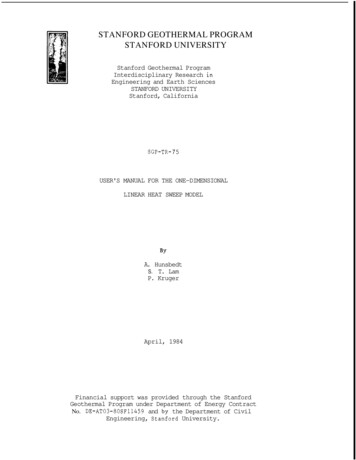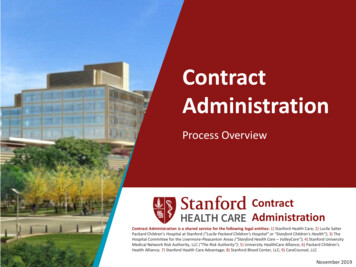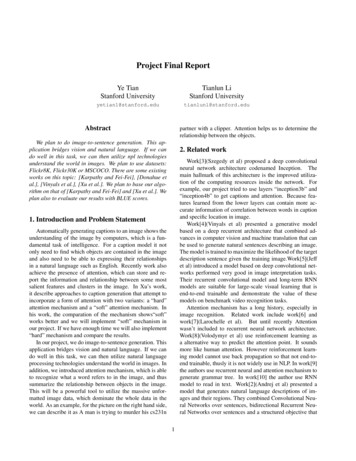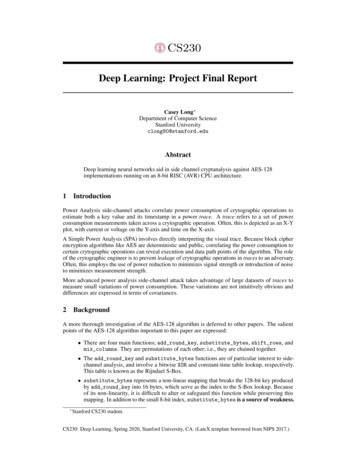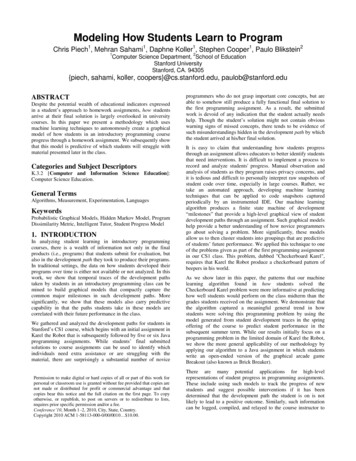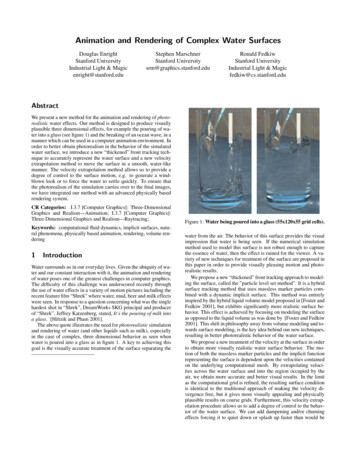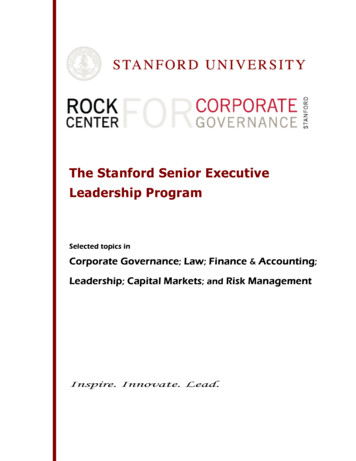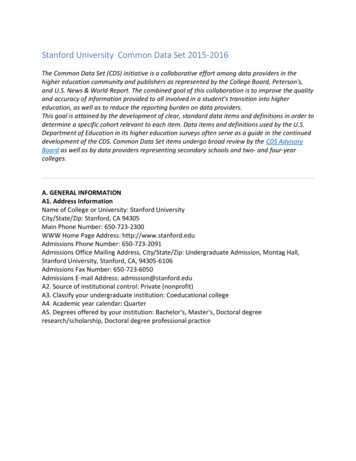
Transcription
Stanford University Common Data Set 2015-2016The Common Data Set (CDS) initiative is a collaborative effort among data providers in thehigher education community and publishers as represented by the College Board, Peterson's,and U.S. News & World Report. The combined goal of this collaboration is to improve the qualityand accuracy of information provided to all involved in a student's transition into highereducation, as well as to reduce the reporting burden on data providers.This goal is attained by the development of clear, standard data items and definitions in order todetermine a specific cohort relevant to each item. Data items and definitions used by the U.S.Department of Education in its higher education surveys often serve as a guide in the continueddevelopment of the CDS. Common Data Set items undergo broad review by the CDS AdvisoryBoard as well as by data providers representing secondary schools and two- and four-yearcolleges.A. GENERAL INFORMATIONA1. Address InformationName of College or University: Stanford UniversityCity/State/Zip: Stanford, CA 94305Main Phone Number: 650-723-2300WWW Home Page Address: http://www.stanford.eduAdmissions Phone Number: 650-723-2091Admissions Office Mailing Address, City/State/Zip: Undergraduate Admission, Montag Hall,Stanford University, Stanford, CA, 94305-6106Admissions Fax Number: 650-723-6050Admissions E-mail Address: admission@stanford.eduA2. Source of institutional control: Private (nonprofit)A3. Classify your undergraduate institution: Coeducational collegeA4. Academic year calendar: QuarterA5. Degrees offered by your institution: Bachelor's, Master's, Doctoral degreeresearch/scholarship, Doctoral degree professional practice
B. ENROLLMENT AND PERSISTENCEB1. Institutional Enrollment, Men and Women, as of October 15, 2015.Full TimeFull Time Part TimePart TimeMenWomen MenWomenDegree-seeking, first-time freshmen86785200Other first-year, degree-seeking183200All other degree-seeking2,7782,44700Total degree seeking3,6633,33100All other undergraduates enrolled in credit courses 3200Total undergraduates3,6663,33300Degree-seeking, first-time1,3598903323All other degree seeking3,9842,508270129All other graduates enrolled in credit courses2711408129Total l all undergraduates: 6,999Total all graduate students: 9,771GRAND TOTAL ALL STUDENTS: 16,770
B2. Enrollment by Racial/Ethnic Category. Provide numbers of undergraduate students foreach of the following categories as of the institution's official fall reporting date or as ofOctober 15, 2015. Include international students only in the category "Nonresident alients."Report as your institution does for IPEDS.Degreeseeking Firsttime, FirstyearDegree-seekingTotal UndergraduatesUndergraduates,(both degree- and non(including first-time, firstdegree-seeking)year)Nonresident aliens177612612Hispanic / Latino2301,0721,072Black or AfricanAmerican, nonHispanic/Latino107425426White, non-Hispanic6252,6142,614American Indian orAlaska Native, nonHispanic/Latino77171Asian, non-Hispanic3851,4321,432Native Hawaiian or otherPacific Islander, non6Hispanic/Latino2222Two or more races, nonHispanic/Latino176725725Race/ethnicity unknown62125Total1,7196,9947,000PersistenceB3. Number of degrees awarded by your institution from July 1, 2014, to June 30, 2015.Bachelor's degrees: 1,671Master's degrees: 2,325Doctoral degrees-research/scholarship: 688Doctoral degrees-professional practice: 273
Graduation RatesThe items in this section correspond to data elements collected by the IPEDS Web-based DataCollection System's Graduation Rate Survey (GRS).For Bachelor's or Equivalent ProgramsFall 2009 CohortReport for the cohort of full-time first-time bachelor's (or equivalent) degree-seekingundergraduate students who entered in Fall 2009. Include in the cohort those who enteredyour institution during the summer term preceding Fall 2009.B4. Initial 2009 cohort of first-time, full-time bachelor's (or equivalent) degree-seekingundergraduate students: 1,692B5. Of the initial 2009 cohort, how many did not persist and did not graduate for the followingreasons: death, permanently disability, service in the armed forces, foreign aid service of thefederal government, or official church missions; total allowable exclusions: 0B6. Final 2009 cohort, after adjusting for allowable exclusions: 1,692B7. Of the initial 2009 cohort, how many completed the program in four years or less: 1,272B8. Of the initial 2009 cohort, how many completed the program in more than four years but infive years or less: 243B9. Of the initial 2009 cohort, how many completed the program in more than five years but insix years or less: 67B10. Total graduating within six years (sum of questions B7, B8, and B9): 1,582B11. Six-year graduation rate for 2009 cohort (question B10 divided by question B6): 93%Fall 2008 CohortReport for the cohort of full-time first-time bachelor's (or equivalent) degree-seekingundergraduate students who entered in Fall 2008. Include in the cohort those who enteredyour institution during the summer term preceding Fall 2008.B4. Initial 2008 cohort of first-time, full-time bachelor's (or equivalent) degree-seekingundergraduate students; total all students: 1,703B5. Of the initial 2008 cohort, how many did not persist and did not graduate for the followingreasons: death, permanently disability, service in the armed forces, foreign aid service of thefederal government, or official church missions; total allowable exclusions: 0
B6. Final 2008 cohort, after adjusting for allowable exclusions: 1,703B7. Of the initial 2008 cohort, how many completed the program in four years or less: 1,298B8. Of the initial 2008 cohort, how many completed the program in more than four years but infive years or less: 249B9. Of the initial 2008 cohort, how many completed the program in more than five years but insix years or less: 64B10. Total graduating within six years (sum of questions B7, B8, and B9): 1,611B11. Six-year graduation rate for 2008 cohort (question B10 divided by question B6): 95%Retention RatesB22. For the cohort of all full-time bachelor's (or equivalent) degree-seeking undergraduatestudents who entered your institution as freshmen in fall 2014 (or the preceding summer term),what percentage was enrolled at your institution as of the date your institution calculates itsofficial enrollment in fall 2015? 98%C. FIRST-TIME, FIRST-YEAR (FRESHMAN) ADMISSIONApplicationsC1. First-time, first-year (freshman) students: Provide the number of degree-seeking, first-time,first-year students who applied, were admitted, and enrolled (full- or part-time) in Fall 2015.Include early decision, early action, and students who began studies during summer in thiscohort. Applicants should include only those students who fulfilled the requirements forconsideration for admission (i.e., who completed actionable applications) and who have beennotified of one of the following actions: admission, non-admission, placement on waiting list, orapplication withdrawn (by applicant or institution). Admitted applicants should include waitlisted students who were subsequently offered admission.Total first-time, first-year (freshman) men who applied: 22,831Total first-time, first-year (freshman) women who applied: 19,666Total first-time, first-year (freshman) men who were admitted: 1,073Total first-time, first-year (freshman) women who were admitted: 1,067Total full-time, first-time, first-year (freshman) men who enrolled: 867Total part-time, first-time, first-year (freshman) men who enrolled: 0Total full-time, first-time, first-year (freshman) women who enrolled: 853Total part-time, first-time, first-year (freshman) women who enrolled: 0C2. Freshman wait-listed students (students who met admission requirements but whose finaladmission was contingent on space availability)Do you have a policy of placing students on a waiting list? YesNumber of qualified applicants offered a place on waiting list: 1,256
Number of wait-listed students who accepted a place on the list: 927Number of wait-listed students admitted: 0Is your waiting list ranked? NoAdmission RequirementsC3. High school completion requirementIdentify your high school completion requirement for degree-seeking entering students:High school diploma is required and GED is acceptedC4. Does your institution require or recommend a general college-preparatory program fordegree-seeking students?RecommendC5. Distribution of high school units required and/or recommended. Specify the distribution ofacademic high school course units required and/or recommended of all or most degree-seekingstudents using Carnegie units (one unit equals one year of study or its equivalent). If you use adifferent system for calculating units, please convert.Units Required Units RecommendedTotal academic units20 English4Mathematics4Science3 Of these, units that must be labs3Foreign language3 Social studies3 Historyincluded in aboveAcademic electivesComputer ScienceVisual/Performing ArtsOther
C6. Do you have an open admission policy, under which virtually all secondary school graduatesor students with GED equivalency diplomas are admitted without regard to academic record,test scores, or other qualifications? NoC7. Relative importance of each of the following academic and nonacademic factors in yourfirst-time, first-year, degree-seeking (freshman) admission decisions.Very Important Important Considered Not consideredAcademicRigor of secondary school record xClass rankxAcademic GPAxStandardized test scoresxApplication essayxRecommendation (s)xNonacademicInterviewxExtracurricular activitiesxTalent/abilityxCharacter/personal qualitiesxFirst generationxAlumni/ae relationxGeographical residencexState residencyxReligious affiliation/commitmentxRacial/ethnic statusxVolunteer workxWork experiencexLevel of applicant interestx
C8. Entrance examsA. Does your institution make use of SAT, ACT or SAT Subject Tests in admission decisions forfirst-time, first-year, degree-seeking applicants? YesIf yes, place check marks in the appropriate boxes below to reflect your institution's policies foruse in admission for Fall 2017.ADMISSIONRequire ConsiderNotRequire Recommend forifusedsomesubmittedSAT orACTxACTOnlySATonlySATandSATSubjectTestsor ACTSATSubjectTestsxB. If your institution will make use of the ACT in admission decisions for first-time, first-year,degree-seeking applicants for Fall 2017, please indicate how the writing component will beused:ACT with Writing component requiredC. If your institution will make use of the SAT in admission decisions for first-time, first-year,degree-seeking applicants for the fall of 2017, please indicate the status of the essay, regardlessof whether the essay score will be used in the admissions process:SAT with ESSAY component required
D. In addition, does your institution use applicants' test scores for academic advising? NoE. Latest date by which SAT or ACT scores must be received for fall-term admission: Jan. 15Latest date by which SAT Subject Test scores must be received for fall-term admission: Jan. 15F. If necessary. clarify your test policies: The ACT Plus Writing or the SAT (Critical Reading, Mathand Writing) is required. SAT Subject Tests are recommended but not required. AP examinationscores are recommended but not required. If English is not your native language, werecommend, but do not require, the Test of English as a Foreign Language (TOEFL).G. Indicate which tests your institution uses for placement:AP: A maximum of 45 quarter units of Advanced Placement may be applied toward theundergraduate degree. Visit the website here for more.Freshman ProfileC9. Percent and number of first-time, first-year (freshman) students enrolled in fall 2015 whosubmitted national standardized (SAT/ACT) test scores. Include information for all enrolled,degree-seeking, first-time, first-year (freshman) students who submitted test scores. Do notinclude partial test scores (e.g., mathematics scores but not critical reading for a category ofstudents) or combine other standardized test results (such as TOEFL) in this item. The 25thpercentile is the score that 25 percent scored at or below; the 75th percentile score is the onethat 25 percent scored at or above.Percent submitting SAT scores: 80%. Number submitting SAT scores: 1,377Percent submitting ACT scores: 51%. Number submitting ACT scores: 8704625th percentile 75th percentileSAT Critical Reading 690780SAT Math700800SAT Writing690780SAT Essayn/an/aACT Composite3135ACT Math3035ACT English3235ACT Writing/English 3033
Percent of first-time, first-year (freshman) students with scores in each range:SAT Critical Reading SAT Math SAT Writing700-800 71.7577.8573.71600-699 24.1119.8322500-599 3.702.113.85400-499 0.440.220.44300-399 000200-299 000ACT Composite ACT English ACT 921.150.4612-1700.3406-11000Below 6 000C10. Percent of all degree-seeking, first-time, first-year (freshman) students who had highschool class rank within each of the following ranges (report information for those studentsfrom whom you collected high school rank information).Percent in top tenth of high school graduating class: 96Percent in top quarter of high school graduating class: 99Percent in top half of high school graduating class: 100Percent in bottom half of high school graduating class: 0Percent in bottom quarter of high school graduating class: 0Percent of total first-time, first-year (freshman) students who submitted high school class rank:35%C11. Percentage of all enrolled, degree-seeking, first-time, first-year (freshman) students whohad high school grade-point averages within each of the following ranges (using 4.0 scale).Report information only for those students from whom you collected high school GPA.Percent who had GPA of 3.75 and higher: 94.51Percent who had GPA of between 3.50 and 3.74: 4.01
Percent who had GPA between 3.25 and 3.49: 0.91Percent who had GPA between 3.00 and 3.24: 0.58Percent who had GPA between 2.50 and 2.99: 0C12. Average high school GPA of all degree-seeking, first-time, first-year (freshman) studentswho submitted GPA: 3.95Percentage of total, first-year (freshman) students who submitted high school GPA: 84.77%Admission PoliciesC13. Application feeDoes your institution have an application fee? YesAmount of application fee: 90Can it be waived for applicants with financial need? YesIf you have an application fee and an on-line application option, please indicate policy forstudents who apply on-line: Same feeCan on-line application fee be waived for applicants with financial need? YesC14. Application closing dateDoes your institution have an application closing date? YesApplication closing date (fall): 01/03C15. Are first-time, first-year students accepted for terms other than the fall? NoC16. Notification to applicants of admission decision sent by: April 1C17. Reply policy for admitted applicants: Must reply by: May 1Deadline for housing deposit: ; Amount of housing deposit: ; Refundable if studentdoes not enroll?C18. Deferred admission: Does your institution allow students to postpone enrollment afteradmission? YesIf yes, maximum period of postponement: 2 yearsC19. Early admission of high school students: Does your institution allow high school studentsto enroll as full-time, first-time, first-year (freshman) students one year or more before highschool graduation? NoC21. Early decision: Does your institution offer an early decision plan (an admission plan thatpermits students to apply and be notified of an admission decision well in advance of theregular notification date and that asks students to commit to attending if accepted) for firsttime, first-year (freshman) applicants for fall enrollment? NoC22. Early action: Do you have a nonbinding early action plan whereby students are notified ofan admission decision well in advance of the regular notification date but do not have tocommit to attending your college? YesIf "yes," please complete the following:Early action closing date: Nov. 1Early action notification date: Dec. 15Is your early action a "restrictive" plan under which you limit students from applying to otherearly plans? Yes
D. TRANSFER ADMISSIONFall ApplicantsD1. Does your institution enroll transfer students? YesIf yes, may transfer students earn advanced standing credit by transferring credits earned fromcourse work completed at other colleges/universities? YesD2. Provide the number of students who applied, were admitted, and enrolled as degreeseeking transfer students in fall 2015.Applicants Admitted Applicants Enrolled ApplicantsMen1,2401310Women 78375Total20152,023Application for AdmissionD3. Indicate terms for which transfers may enroll: FallD4. Must a transfer applicant have a minimum number of credits completed or else must applyas an entering freshman? NoD5. Indicate all items required of transfer students to apply for admission:Requiredof allHigh schooltranscriptxCollege transcript(s)xEssay or personalstatementxInterviewRecommendedof allRecommendedof someRequiredof someNotrequiredxStandardized testscoresxStatement of goodstanding from priorinstitution(s)x
D6. If a minimum high school grade point average is required of transfer applicants, specify(on a 4.0 scale):D7. If a minimum college grade point average is required of transfer applicants, specify(on a 4.0 scale):D8. List any other application requirements specific to transfer applicants:D9. List application priority, closing, notification, and candidate reply dates for transferstudents.Priority Closing Notification ReplyDateDateDateDateFallMarchMay 1515June1D10. Does an open admission policy, if reported, apply to transfer students? NoD11. Describe additional requirements for transfer admission, if applicable:Transfer Credit PoliciesD12. Report the lowest grade earned for any course that may be transferred for credit: CD13. Maximum number of credits or courses that may be transferred from a two-yearinstitution:Number: 90 Unit type: quarterD14. Maximum number of credits or courses that may be transferred from a four-yearinstitution:Number: 90 Unit type: quarterD15. Minimum number of credits that transfers must complete at your institution to earn anassociate degree: N/AD16. Minimum number of credits that transfers must complete at your institution to earn abachelor's degree: 90D17. Describe other transfer credit policies:Credit from another institution will be transferred for courses that are substantially equivalentto those offered at Stanford University on the undergraduate level, subject to the approval ofthe credit evaluator. A maximum of 20 quarter units may represent courses that do not parallelspecific courses at Stanford, again, subject to the approval of the credit evaluator as to qualityand suitability.Credit earned in extension and correspondence courses is transferable only if the universityoffering the courses allows that credit toward its own bachelor's degree. Such credit is limitedto a maximum of 45 quarter units for extension courses, a maximum of 15 quarter units forcorrespondence study, and a maximum of 45 quarter units for the combination of extensionand correspondence courses.
E. ACADEMIC OFFERINGS AND POLICIESE1. Special study options: Identify those programs available at your institution:Accelerated programHonors programxCooperative work-study programIndependent studyxCross-registrationInternshipsxDistance learningxLiberal arts/career combinationDouble majorxStudent-designed majorxDual enrollmentStudy abroadxEnglish as a second languageTeacher certification programExchange student program (domestic) xWeekend collegeExternal degree programOther: Marine research center, Stanford in Washington, Stanford in NYC
E3. Areas in which all or most students are required to complete some course work prior tograduation:Arts/fine artsHumanitiesComputer LiteracyMathematicsEnglish (including composition) xPhilosophyForeign LanguagexSciencesHistorySocial ScienceOther: Undergraduates complete at least 180 units, including requirements for the major,writing and rhetoric requirements, one year of a foreign language and courses in the followingareas: Thinking Matters: One-quarter course in the freshman yearWays of Thinking, Ways of Doing: Eleven courses in eight subject areas, includingaesthetic and interpretive inquiry, social inquiry, scientific analysis,formal reasoning,quantitative reasoning, engaging diversity, moral and ethical reasoning and creativeexpression.
F. STUDENT LIFEF1. Percentages of first-time, first-year (freshman) students and all degree-seekingundergraduates enrolled in fall 2015 who fit the following categories:FreshmenAllUndergraduatesPercent who are from out of state6361Percent of men who join fraternities020Percent of women who join sororities020Percent who live in college owned, operated or affiliatedhousing10093Percent who live off campus or commute07Percent of students age 25 and older01Average age of full-time students1820Average age of all students1820* includes off campus, Stanford in Washington and overseas campuses.F2. Activities offered:Choral groupsxConcert BandxDancexDance/theaterxJazz bandxLiterary magazinexMarching bandxMusic ensemblesxMusical theaterxOperax
Pep bandxRadio stationxStudent governmentxStudent newspaperxStudent-run film societyxSymphony orchestraxTelevision stationxYearbookxCampus MinistriesxModel United NationalxInternational Student Organizations xF3. ROTC (programs offered at cooperating institutions)Army ROTC is offered at Santa Clara UniversityNaval ROTC is offered at UC BerkeleyAir Force ROTC is offered at San Jose UniversityF4. HousingCoed dormsxMen's dormsWomen's dormxApartments for married studentsxApartments for single studentsxSpecial housing for disabled studentsxSpecial housing for international studentsFraternity/sorority housingxCooperative housingxOther: academic, cross-cultural, language theme and ethnic theme xG. ANNUAL EXPENSESG0. Link to Stanford University's net price calculator
Below are the 2015-2016 academic year costs for Stanford University:X Check here if your institution's 2016-2017 academic year costs are not available at this timeand provide an approximate date (i.e., month/day) when your institution's final academic yearcosts will be available: February 2016.G1. Undergraduate full-time tuition, required fees, room and boardList the typical tuition, required fees, and room and board for a full-time undergraduate studentfor the FULL 2015-2016 academic year. A full academic year refers to the period of timegenerally extending from September to June; usually equated to two semesters, two trimesters,three quarters, or the period covered by a four-one-four plan. Room and board is defined asdouble occupancy and 19 meals per week or the maximum meal plan. Required fees includeonly charges that all full-time students must pay that are not included in tuition (e.g.,registration, health, or activity fees.) Do not include optional fees (e.g., parking, laboratoryuse).FIRST-YEARUNDERGRADUATESTuition 45,729 45,729Required Fees 591 591Room and Board 14,107 14,107Room Only 8,346 8,346Board Only 5,761 5,761Comprehensive tuition and room and board fee (if your college cannot provide separate tuitionand room and board fees):Other:G2. Number of credits per term a student can take for the stated full-time tuition: 12 minimum,23 maximumG3. Do tuition and fees vary by year of study (e.g., sophomore, junior, senior)? NoG4. Do tuition and feeds vary by undergraduate instructional program? No
G5. Provide the estimated expenses for a typical full-time undergraduate student for 201314:Books/suppliesResidentsCommuters living athomeCommuters not living athome 1,425 1,425 1,425Room onlyBoard only 4,770Room and boardtotal 14,107Transportation 700 1,134 700Other expenses 2,625 3,159 2,625H. FINANCIAL AIDAid Awarded to Enrolled UndergraduatesH1. Enter total dollar amounts awarded to full-time and less than full-time degree-seekingundergraduates in the following categories. Include aid awarded to international students (i.e.,those not qualifying for federal aid). Aid that is non-need-based but that was used to meetneed should be reported in the need-based aid column.Indicate the academic year for which data are reported for items H1, H2, H2A, and H6: 20142015 FinalWhich needs-analysis methodology does your institution use in awarding institutional aid?Federal methodology (FM)Institutional methodology (IM)X Both FM and IMNeed based Non needbased Federal 6,557,064 720,081State (i.e., all states) 3,256,763 18,307Institutional (Endowed scholarships, annual gifts and tuitionfunded grants, awarded by the college) 129,855,337 1,129,137Scholarships/Grants
Scholarships/grants from external sources (e.g., Kiwanis,National Merit) not awarded by the college 4,496,592Total Scholarships/Grants 144,165,756 7,001,479 5,133,954Self HelpStudent loans from all sources (excluding parent loans) 2,093,779Federal work study 1,356,595State and other work study employment 3,394,724 539,600Total Self Help 6,845,098 6,277,127Parent Loans 5,737,527 5,264,860Tuition Waivers 249,271 2,689,473Athletic Awards 2,519,842 17,036,565H2. Number of Enrolled Students Receiving Aid: List the number of degree-seeking full-timeand less-than-full-time undergraduates who applied for and received financial aid from anysource. Aid that is non-need-based but that was used to meet need should be counted as needbased aid. Numbers should reflect the cohort receiving the dollars reported in H1. Note: In thechart below, students may be counted in more than one row, and full-time freshmen shouldalso be counted as full-time me,Undergrad(IncludingFreshmen)a) Number of degree-seekingundergraduate students1,6786,886b) Number of students in line a whoapplied for need-based financial aid9973,821c) Number of students in line b who weredetermined to have financial need8113,457d) Number of students in line c whoreceived any financial aid7903,399Less Than FullTimeUndergraduate
e) Number of students in line d who wereawarded scholarship or grant aid7743,343f) Number of students in line d who wereawarded any need-based self-help aid4682,585g) Number of students in line d who wereawarded any non-need-based scholarshipor grant aid2093h) Number of students in line d whoseneed was fully met (excluding PLUS loans,738unsubsidized loans, and privatealternative loans)3,055i) On average, the percentage of need thatwas met of students who were awardedany need-based aid. Exclude aid that was100%awarded in excess of need as well as anyresources that were awarded to replaceEFC100%j) The average financial aid package ofthose in line d. Exclude any resources that 46,438were awarded to replace EFC 45,923k) Average need-based scholarship ofgrant award of those in line e 43,291 43,167l) Average need-based self-help award ofthose in line f 2,234 2,594m) Average need-based loan of those inline f who received a need-based loan 2,580 3,114
H2A. Number of Enrolled Students Awarded Non-need-based Scholarships and Grants: Listthe number of degree-seeking full-time and less-than-full-time undergraduates who had nofinancial need and who were awarded institutional non-need-based scholarship or grant aid.Numbers should reflect the cohort awarded the dollars reported in H1. Note: In the chartbelow, students may be counted in more than one row, and full-time freshmen should also becounted as full-time meUndergraduates(including Freshmen)n) Number of students in line a who had no financialneed and who were awarded non-need-based0scholarship or grant aid (excluding those who wereawarded athletic awards and tuition benefits)31o) Average dollar amount of institutional non-needbased scholarship and grant aid awarded to students 0in line n 13,501p) Number of students in line a who were awardedan institutional non-need-based athletic grant orscholarship116455q) Average dollar amount of institutional non-needbased athletic grants and grants awarded tostudents in line p 30,902 37,443
H4. Provide the number of students in the 2015 undergraduate class who started at yourinstitution as first-time students and received a bachelor's degree between July 1, 2014 andJune 30, 2015. Exclude students who transferred to your institution: 1,623Percent ofNumber inthe classthe(definedclass(defined above)in H4 above) whowhoborrowedborrowed(nearest1%)Average d, ofthose in the firstcolumn (nearest 1)a) Any loan program: Federal Perkins, Federal StaffordSubsidized and Unsubsidized, Institutional, state,private loans that your institution is aware of, etc.Include both Federal Direct Student Loan and FederalEducation Loans.35622% 21,238b) Federal loan programs: Federal Perkins, FederalStafford Subsidized and Unsubsidized. Include bothFederal Direct Student Loans and Federal FamilyEducation Loans.34421% 16,358c) Institutional loan programs.121% 5,298d) State loan programs.00% 0e.) Private alternative loans made by a bank or lender.533% 35,277Aid to Undergraduate Degree-seeking Nonresident AliensH6. Indicate your institution's policy regarding institutional scholarship and grant forundergraduate degree-seeking nonresident aliens:Institutional need-based scholarship or grant aid is availableInstitutional non-need based scholarship of grant aid is availableIf institutional financial aid is available for undergraduate degree-seeking nonresident aliens,provide the number of undergraduate degree-seeking nonresident aliens who received needbased or non-need-based aid: 149Average dollar amount awarded to undergraduate degree-seeking nonresident aliens: 55,362Total dollar amount of institutional financial aid awarded to all undergraduate degree-seeking
nonresident aliens: 8,208,946P
Admissions Phone Number: 650-723-2091 Admissions Office Mailing Address, City/State/Zip: Undergraduate Admission, Montag Hall, Stanford University, Stanford, CA, 94305-6106 Admissions Fax Number: 650-723-6050 Admissions E-mail Address: admission@stanford.edu A2. Source of institutional control: Private (nonprofit) A3. Classify your .
